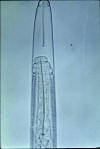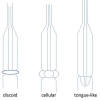 |
Molting of cuticle in Belonolaimus longicaudatus.
Note that stylet cone is shed with cuticle. Photograph from Society of Nematologists |
 |
Molting of cuticle in Belonolaimus longicaudatus.
Note that stylet cone is shed with cuticle. Photograph from Society of Nematologists |
Three parts:
Consists of:
Lips - hexaradiate - usually six, reduced to 3 in Ascarids, 2 in Spirurida. Lips may be extended into probolae and other ornamentation, - e.g. Cephaloboidea - Cephalobus.
Stoma - buccal cavity - movable and immovable armament common in all Nematoda - teeth, etc.
| Globose buccal cavity | some predaceous nematodes |
| Tubular buccal cavity | some bacterivores |
| Protrusible spears in two orders: Tylenchida and Dorylaimida |
|
|
Tylenchida: |
Dorylaimida: |
| anterior conical portion (with
subterminal ventral opening), shaft, knobs.
cone is shed, shaft and knobs are resorbed at molt. cone of stomatostyle from anterior of stoma - embryological origin is the cheilostome. Shaft, knobs are esophageal, from the esophastome. stomatostyle often distinguished by referring to it as the stylet. |
odontostyle appears to form in a cell that is esophageal in position, but that cell is one that has probably migrated from the stoma region. odontophore is esophageal - from the esophastome. odontostyle often distinguished by referring to it as the spear. |
Esophagus - a variety of forms in different Orders - 2-part, 3-part.
Some dorylaimid esophago-intestinal cardia configurations
In the order Tylenchida (which contains many plant feeders) the esophagus and glands are surrounded by membrane. Thee relationship of the esaophageal glands and intestine (overlap or abutting) can be diagnostic. The DEGO (dorsal esophageal gland opening) is ducted to the anterior and opens into the esophageal lumen (suborder Tylenchina) or into the metacorpus (suborder Aphelenchina). ((Maggenti, Ferris).
One or two testes (monorchic/diorchic), one or two ovaries (monovarial/diovarial).
Testis(es), spicules, gubernaculum, caudal alae are all of diagnostic value.
Testes:
Spicules - paired, crescent-shaped, cytoplasm core, nerves. Spread vulva to allow entry of sperm. Their size and shape diagnostic. They may be fused at tip.
Gubernaculum - if present, a guiding structure for spicules, grooved.
Supplements - glands of secretion and attachment. Ventromedian supplements have copulatory function.
Rays - genital papillae embedded in caudal alae in some forms (sensory, tactile function?).
Caudal alae (bursa) - cuticular origin.
Sperm - generally non-flagellate, amoeboid.
Vulval position diagnostic.
One or two ovaries (monovarial/ diovarial), outstretched or reflexed.
Two uteri, opposed - didelphic/ amphidelphic.
One uterus directed forward - monodelphic/prodelphic.
One uterus directed backward - monodelphic/opisthodelphic.
Monodelphic reproductive systems may have a post-uterine sac as a relic of the didelphic system.
Ovaries may show various configurations beyond uteri - outstretched, reflexed, etc. All have the germinal zone at the distal end.
There may be a spermatheca for storage of sperm received in copulation. Usually located between the ovary and uterus.
Between the ovary and uterus is the crustaformeria, a specialized region in which the egg shell is deposited.
Nematodes have a variety of sensilla:
(i) Amphids
(ii) Phasmids
(iii) Other Sensilla
Simple tubular system - in one or both lateral hupodermal chords in Secernentea; embedded between the three cell bodies in hypodermal chord.
Individual excretory cells or tubular system in Adenophorea.
Excretory pore (external opening of tubular excretory systems) usually visible due to cuticular lining - ventral, position is diagnostic.
Return to Phylum Nemata Menu